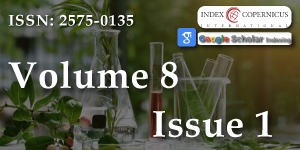New Fungi Associated with Blackberry Root Rot (Rubus spp.), in Michoacán, Mexico
Main Article Content
Abstract
Los Reyes, Michoacán, Mexico, is one of the main blackberry-producing places in the world, however, the disease located at the root level has caused important economic losses. Currently has been reported that the fungus Fusarium spp., is the main causal agent but actions to control it have failed. The objective of this work was to identify the possible presence of unreported pathogenic fungi in the root system of the blackberry and identify them molecularly. It was sampled in a commercial open-air orchard from Los Reyes, pieces of roots were taken from symptomatic plants with wilting and decay. The fungi were isolated in the laboratory, identified with taxonomic keys, extraction was performed, and the sequences obtained were compared with those reported in the NCBI gene bank. Among the results obtained were Kalmusia italica, Epicoccum nigrum, Microsphaeropsis arundinis, Achizophyllum commune, and, as expected, some species of Fusarium spp.
Article Details
Copyright (c) 2024 Vargas LMT, et al.

This work is licensed under a Creative Commons Attribution 4.0 International License.
SADER. 2019. https://www.gob.mx/agricultura/colima/articulos/la-zarzamora-cada-dia-mas-mexicana-235435?idiom=es
Fernández-Pavía SP, Rodríguez-Alvarado GR, Gómez-Dorantes N, Gregorio-Cipriano MR y Fernández-Pavía YL. Enfermedades en plantas en el estado de Michoacán. Biológicas. 2012; 14(2):75-89.
Lévesque CA, Harlton CE, de Cock AW. Identification of some oomycetes by reverse dot blot hybridization. Phytopathology. 1998 Mar;88(3):213-22. doi: 10.1094/PHYTO.1998.88.3.213. PMID: 18944967.
Leslie JF, Summerell BA. Fusarium laboratory workshops-A recent history. Mycotoxin Res. 2006 Jun;22(2):73-4. doi: 10.1007/BF02956766. PMID: 23605575.
Doyle JJ, Doyle JL. Isolation of plant DNA from fresh tissue. Focus. 1990; 12:13-15.
Liu JK, Hyde KD, Jones EG, Ariyawansa HA, Bhat DJ, Boonmee S, Camporesi E. Fungal diversity notes 1–110: taxonomic and phylogenetic contributions to fungal species. Fungal diversity. 2015; 72:1-197.
Ellis MB. Dematiaceous hyphomycetes. Commonwealth Mycological Institute, Kew. 1971; 608.
Pendle S, Weeks K, Priest M, Gill A, Hudson B, Kotsiou G, Pritchard R. Phaeohyphomycotic soft tissue infections caused by the coelomycetous fungus Microsphaeropsis arundinis. J Clin Microbiol. 2004 Nov;42(11):5315-9. doi: 10.1128/JCM.42.11.5315-5319.2004. PMID: 15528731; PMCID: PMC525150.
Chowdhary A, Randhawa HS, Gaur SN, Agarwal K, Kathuria S, Roy P, Klaassen CH, Meis JF. Schizophyllum commune as an emerging fungal pathogen: a review and report of two cases. Mycoses. 2013 Jan;56(1):1-10. doi: 10.1111/j.1439-0507.2012.02190.x. Epub 2012 Apr 23. PMID: 22524529.
Sumathi S, Priyanka V, Krishnapriya V, Suganya K. Identification of a novel strain of fungus Kalmusia italica from untouched marine soil and its heavy metal tolerance activity. Bioremediation Journal. 2021; 25(2):91-107.
Li T, Im J, Lee J. Genetic Diversity of Epicoccum nigrum and its Effects on Fusarium graminearum. Mycobiology. 2022 Dec 13;50(6):457-466. doi: 10.1080/12298093.2022.2148394. PMID: 36721792; PMCID: PMC9848293.
Botero WB, Amorim MRD, Carlos IZ, Polesi MC, Santos LCD. Aromatic Polyketides and Macrolides from Microsphaeropsis arundinis. Journal of the Brazilian Chemical Society. 2020; 31:364-369.
Schmidt O, Liese W. Variability of wood degrading enzymes of Schizophyllum commune. Holzforschung. 1980; 34:67–72.
De Jong JF. Aerial Hyphae of Schizophyllum commune: Their Function and Formation. PhD thesis, Univ. Utrecht. 2006.
Aoki T, O´Donnell K, Scandiani MM. Sudden death syndrome of soybean in South America is caused by four species of Fusarium: Fusarium brasiliense sp. Nov., F. cuneirostrum sp. Nov., F. tucumaniae, and F. virguliforme. Mycoscience. 2005; 46:162-183.
Fernández-Ortuño D, Loza-Reyes E, Atkins SL, Fraaije BA. The CYP51C gene, a reliable marker to resolve interspecific phylogenetic relationships within the Fusarium species complex and a novel target for species-specific PCR. Int J Food Microbiol. 2010 Dec 15;144(2):301-9. doi: 10.1016/j.ijfoodmicro.2010.10.013. Epub 2010 Oct 21. PMID: 21071105.

